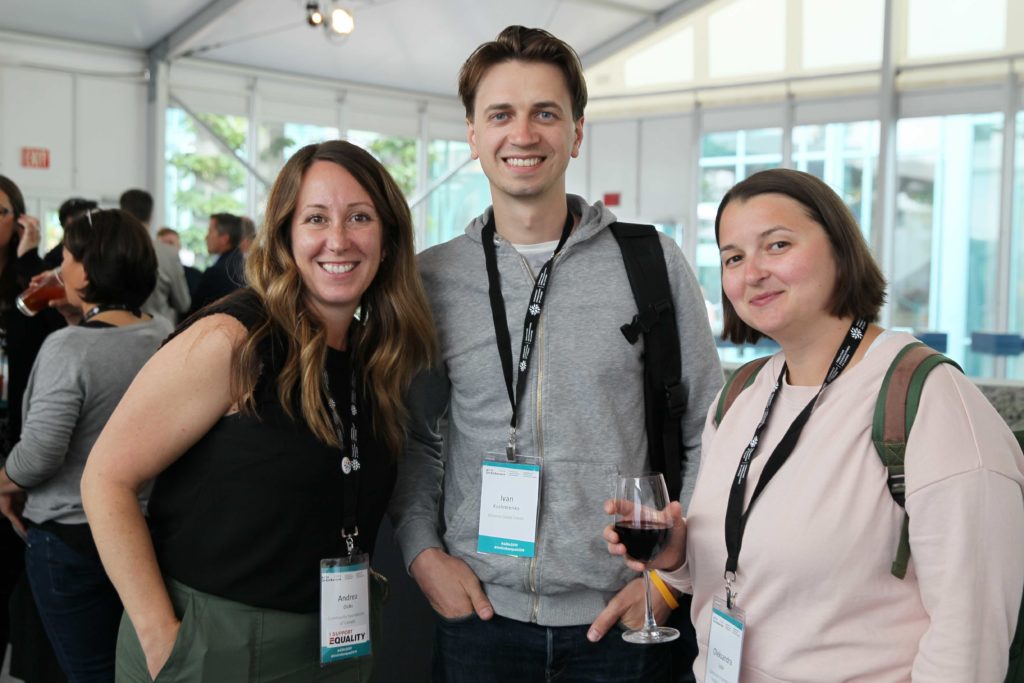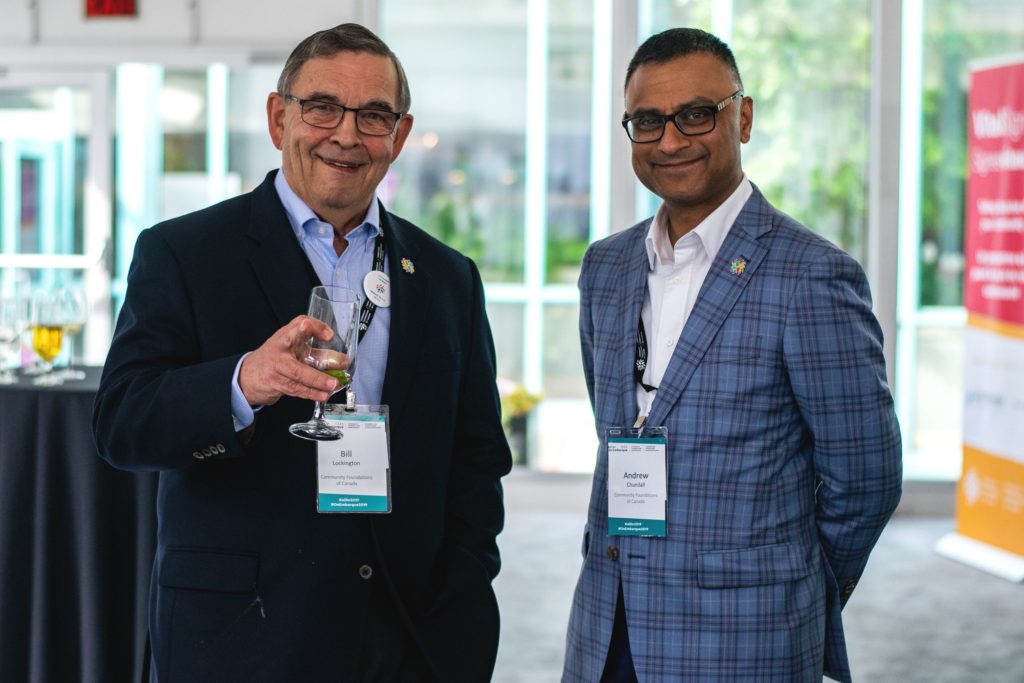(April 1, 2020) On March 31st, The Charity Report spoke with Community Foundations of Canada president, Andrea Dicks and CEO Andrew Chunilall. Over the last few weeks, we have been in touch with many community foundations across the country and is seeing a new vision of philanthropy emerging, a vision that is based in the needs of the community and prioritizes the needs of its people. Community Foundations Canada is a network of 191 community foundations that operate across Canada. This interview has been edited for length and clarity.

Gail Picco: Andrew and Andrea, it’s good to have this opportunity to talk to you. I’ve been talking to community foundations across the country for the last couple of weeks. And it’s really inspiring what’s going on at the community level, surprising in one way, which we can talk about later, but also inspiring. We’ll start with you, Andrea, what’s been most surprising and inspiring for you over the last couple of weeks?
Andrea Dicks: I love that question. That’s a wonderful question to start with. It would be understandable, because of human nature, for the response of community foundations to pause and to really consider how to protect their entity. In a time of uncertainty, what we’re seeing is the opposite. And that’s what I find so inspiring. Instead of protectionist posture, we’re seeing community foundations stepping forward with open arms to say, what can we do, how can we use all of our assets in terms of our people, our voice to lean into supporting our community, because they need us now more than ever. At the same time, they’re thinking about all of the tools that they have in their toolkit and really using those tools.
As one community foundation leader said on a call, “you know, we are in an extraordinary time. And in an in an extraordinary moment, an extraordinary response is required.”
Gail Picco: Andrew, is that your experience? What’s caught your interest over the last couple of weeks?
Andrew Chunilall: Andrea and I were both times reflecting on the financial crisis in 2007 and 2008 and drawing some comparisons. We see people being responsive, as Andrea said, trying to attend to very basic physical and psychological needs of people and institutions. We also see that there’s a growing sentiment around the future and recognizing the future will not likely be a rebound into what was, but an opportunity to create new institutions and new ways of working. What we thought might take 10 years, might be before us in the very foreseeable future.
Gail Picco: One of the things that surprised me about the response from community foundations is that over a period of time, you see start seeing them as a collection of donor advised funds as opposed to organizations that can really leap into the breach. Yet, despite the fact that a lot of the community foundation funding is restricted, many community foundations—from Vancouver to Winnipeg to Saskatchewan to the east coast have decided to go all in on this one. Why do the you think that is?
Andrea Dicks: I’ve been part of the community foundation movement for over 10 years, was the executive director of a community foundation. And I would say that over the 10 years I’ve been part of the movement—Andrew can comment because he’s been around for a few more years than I have—there’s has been an emergence of more holistic and community leadership driven initiatives. There’s the Vital Signs program, where community foundations put together local information that’s both statistical and grounded in perception. It’s an example of how community foundations have been more than just funders. They’re active relationship builders, active partners within their community who are working across their community to leverage local knowledge to make decisions and build an infrastructure of support for their community.
I think we’re seeing community foundations step forward in response to COVID-19 because they have such an intricate level of community knowledge. They are hearing firsthand about the experiences of organizations working on the frontlines.
They are hearing about organizations that have had to shut down because they can’t host cultural events. community foundations have this web of relationships, and so everything is feeding back into them. They’re perfectly positioned to respond, because they have the information already. They’re moving fast and quickly because they’re at that local level.
Gail Picco: Andrew, what are you hearing about the needs of the community at this stage? Where are the priority concerns?

Andrew Chunilall: Right now, it looks different in different communities. We have a very complex, diverse country and how this plays out in northern communities versus rural or urban involves a different set of actors and a different set of priorities.
But for the most part, it’s those frontline agencies that are dealing with things like homelessness, poverty, mental health issues, agencies that work in compliment to the broader healthcare system.
Right now, our community foundations have a framework for allocating resources, which is pretty much from the bottom up. There are a lot of urgent needs. Where do we do the best? Where do we make the most optimized decisions?
I’ll put it in two buckets. The first is intersection. When you can find an organization that has the intersection of, for example, women’s shelters, people with mental health issues, elder care or Indigenous communities, you want to get the most out of those partnerships. You are also looking at interdependence, understanding people holistically, you can’t provide shelter and not food. You’re trying to meet people where they are, take care of people in an urgent and quickly changing landscape. It’s a complicated landscape the Vancouver foundation is playing it out differently than a community foundation in northern Quebec.

Andrea Dicks: I just wanted to add, and I agree with what Andrew had said, that the other piece that’s important to recognize is that community foundations are thinking about an immediate response. They’re also looking at the sector as a whole that employs 2.4 million people across Canada. And those 2.4 million people are important to community. Community foundations are thinking about addressing the needs of the full breadth of the charitable sector, including employees. There’s a lot of activity to expose and approach. I think is part of the magic of a community foundation.
Gail Picco: Andrew, I’m going to ask you this question. But I’d also like to hear from Andrea on it. I think it’s pretty clear, from an objective stance, that community foundations have really been able to leverage their assets and their knowledge of the community to respond in this crisis. And that doesn’t come out of nowhere. I mean, pandemic responses don’t come out of nowhere. They come out of a lot of rehearsal and a lot of planning. And it seems to me community foundations have been doing this over the past 10 years and that has led to their ability to be able to respond in this moment. Moving forward, do you see community foundations entering a new phase in their development where they are more than a collection of donor-advised funds and are a significant way for investment to be made on a community level. Andrew, do you see this as a sign of evolution in the way that community foundations operate?
Andrew Chunilall: Yes, maybe just two quick contextual pieces and more of a direct answer. I think number one, we’ve learned lessons from the financial crisis in 2007 and 2008. And the lesson we learned was that our business model was too closely tied to the economic growth of the economy, that we were very strong and robust when the economy was good and producing. But when the economy tanked, and people really needed us, our business model also suffered. Then we started to look at how do we flatten this thing out a little bit and be a lot more responsive when people really need us.I think we’re seeing that play out right now.
The other thing is that we’ve been under what I’ll call criticism and skepticism for a few years now. Whether its books like Winners Take All or Decolonizing Wealth, or the myriad of newspaper articles that have called philanthropy and capitalism onto the mat, we have been listening to that criticism and skepticism. And we have been in agreement with some of it and really taken it on as a challenge to be more responsive.
We do so see this as a black swan event. I think we are more ready now. And we were in the process of being really ready. But we couldn’t have predicted this event at this particular point in time. Now, the question for me is, whether this particular pandemic will actually accelerate change.
And I think we are also going to see a push that involves the door advised fund … and that those who have been most successful at this game of capitalism have extra wealth to do good with. And that’s been a wonderful thing. And that’s brought us here. At the same time our community foundation’s purpose isn’t as a donor. Our purpose is community.
And we’ve also been following closely with what the corporate world is doing.
The Business Roundtable in the fall issued a letter which challenged shareholder primacy, which goes way back to the hypotheses that shareholders are the number one thing to consider for corporations. Well, in our world, the equivalent would be donors, but we’re questioning that now and that we actually have a broader purpose, and that is our community. Our decision making isn’t only about donors and putting them first, it’s about a much broader stakeholder group.
Andrea Dicks: I would really encourage the labeling of community foundations as being just of donor advised funds is a thing of the past and that community foundations has already evolved.

Gail Picco: Andrew, can I ask you one last question, and I don’t know if you’re going to have the answer. But what have you been hearing about the federal government’s plan to help subsidize the wages of people who work in charities and non-profits? Are you seeing this as something that people are going to be able to take advantage of, or are people not sure yet?
Andrew Chunilall: I think the announcement yesterday provided some clarity. But we are part of a larger sector wide conversation about the ways in which the different stimulus packages that have been announced already will impact the charitable and non-profit sector. So, we see some of the announcement as quite positive. We’re also part of a collective of organizations that are putting forward more opportunities to government. We’re quite optimistic. I don’t have any inside baseball to share, but we are quite optimistic that the conversation will continue. We are really impressed with our colleagues and the way in which the sector has come together to advocate for itself.
Leave a Reply
You must be logged in to post a comment.